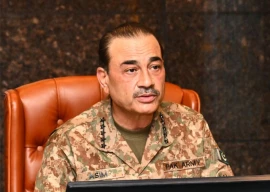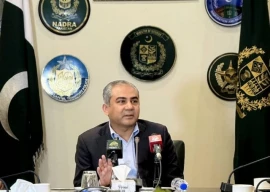
Neither State Bank of Pakistan (SBP) Governor Tariq Bajwa nor Adviser to Prime Minister on Finance Dr Miftah Ismail contested the claim made by Dr Abid Hasan during an EAC meeting held early this month, a member of the EAC confided to The Express Tribune. Prime Minister Shahid Khaqan Abbasi chaired the meeting.
Bajwa was said to have affirmed the claim made by Hasan, officials said. Bajwa is currently in the United States and could not be approached for comments.
The EAC member questioned the rationale of pumping $7 billion in the last couple of years to defend a policy that according to him caused more damage, said sources in the EAC. It is believed that the money that the central bank threw in the market was borrowed.
Govt uses 'best tool in hand', allows rupee fall
The central bank’s support for the rupee came before the government’s decision to finally let the currency depreciate against the US dollar by around 10% in two rounds since December 2017.
Former finance minister Ishaq Dar was a strong proponent of an overvalued exchange rate due to the negative implications of depreciation for inflation and the country’s mounting public debt.
Dar had got acting SBP governor Riaz Riazuddin removed after he let the rupee depreciate by about 3.4% in July last year. Subsequently, Dar appointed Bajwa as the SBP governor to keep the rupee strong.
However, after Dar’s exit, the SBP let the rupee weaken twice, bringing it closer to its real value.
Officials said Hasan, a former country director of the World Bank, asked the prime minister that somebody should be held responsible for executing a flawed exchange rate policy.
Rupee depreciation only a temporary relief for exporters
The SBP chief spokesman did not respond to request for comments. Hasan also declined to comment.
During four and a half years, the PML-N government has acquired gross foreign loans of $41 billion. If one goes by Hasan’s statement, 17% of the loans were consumed only in defending the exchange rate.
The inflation-adjusted exchange rate actually appreciated by almost 19% from 2014-15 to 2016-17, said a recent International Monetary Fund (IMF) report. According to the IMF, gross international reserves had declined due to “limited exchange rate flexibility”.
In 2013, one US dollar was equal to Rs98.70. Before the rupee weakened to its current value of Rs115.70, it had shed only 6.2% in the first four years of the government. In the past four months, the rupee fell about 10%.
The IMF noted in its report that due to the stagnant value of the rupee, the change in public debt was only 0.5% in 2016. There was no effect of the exchange rate on public debt in 2017 as Dar kept the rate unchanged.
Opponents of the rigid exchange rate policy argued that it adversely affected country’s exports and foreign currency reserves.
In its post-programme monitoring report, the IMF said Pakistan’s net international reserves were negative $724 million by February 15 of the current year against positive $7.5 billion at the expiry of the IMF programme in September 2016. This was the period when the central bank pumped reserves into the market.
The IMF said maintaining a largely stable nominal exchange rate amid mounting external pressure had led to the loss of international reserves. Despite significant external borrowing by the government, the SBP’s gross reserves declined from $18.5 billion at the end of the IMF programme to $11.4 billion.
Pakistan and its financial inclusion target
However, there was also some merit in keeping the exchange rate stable. After the depreciation, the public debt jumped by about Rs700 billion without even borrowing a single dollar. This also pushed the public debt-to-GDP ratio to 70.1% and about 2% of it was because of the depreciation.
The external debt-to-GDP ratio was sensitive mostly to the current account and exchange rate shocks. Because of these shocks, the external debt ratio could exceed 45% under the real depreciation shock scenario, according to the IMF report.
Published in The Express Tribune, April 21st, 2018.
Like Business on Facebook, follow @TribuneBiz on Twitter to stay informed and join in the conversation.








1726054615-0/OpenAI-(2)1726054615-0-270x192.webp)









COMMENTS
Comments are moderated and generally will be posted if they are on-topic and not abusive.
For more information, please see our Comments FAQ